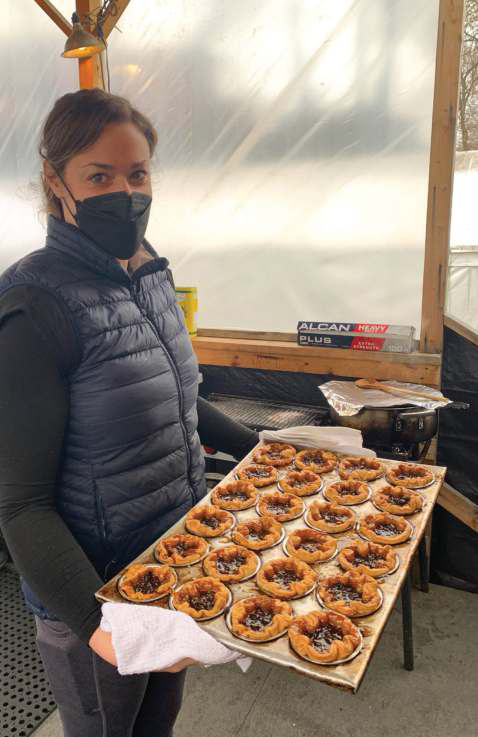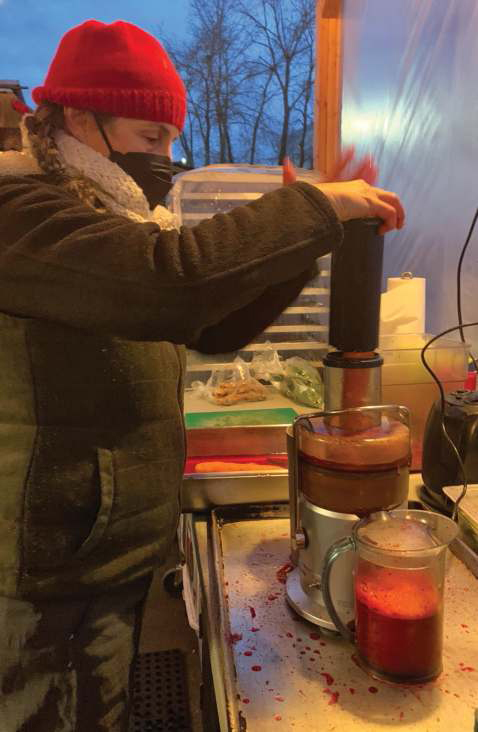Chefs in restaurants have undeniably tough jobs, with long hours trying to keep diners happy while dealing with the pressures of running a business.
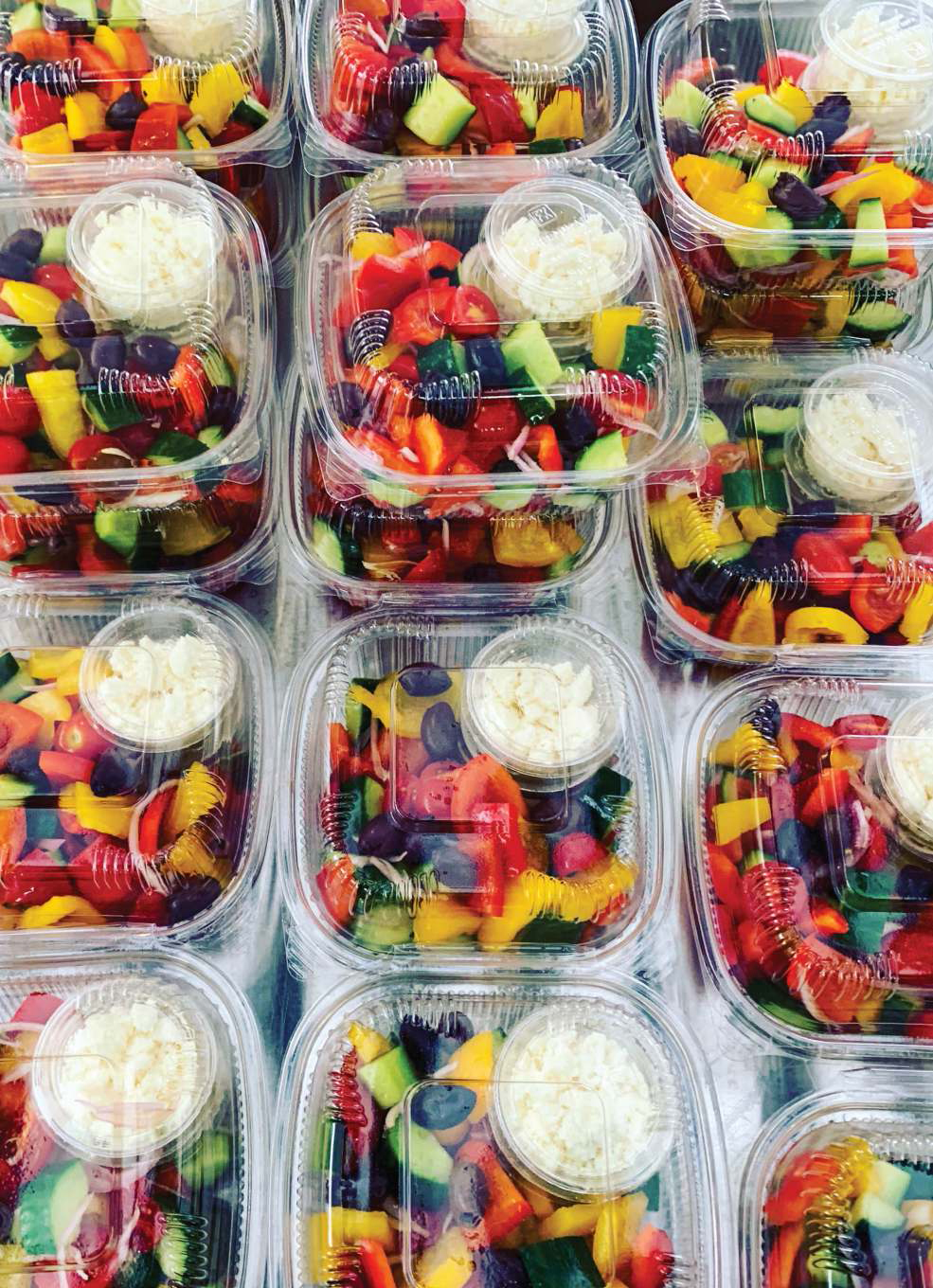
Now imagine trying to serve two meals a day to more than 100 people out of a truck, worrying about whether you will run out of propane or have to pack up and move to a new location between breakfast and lunch. Throw in the curveballs of a lot of high-profile customers with last-minute whims and dietary fads, and unpredictable hours in all kinds of weather, day after day and night after night. Maybe for months. With a smile. That’s the world of a film caterer.
A lot has changed since I started as a chef with Reel Appetites back in 1987; I later bought the company, turning it into the biggest film-catering outfit in Canada. But some things have stayed the same, including the 2:00 a.m. wake-up call to start the workday.
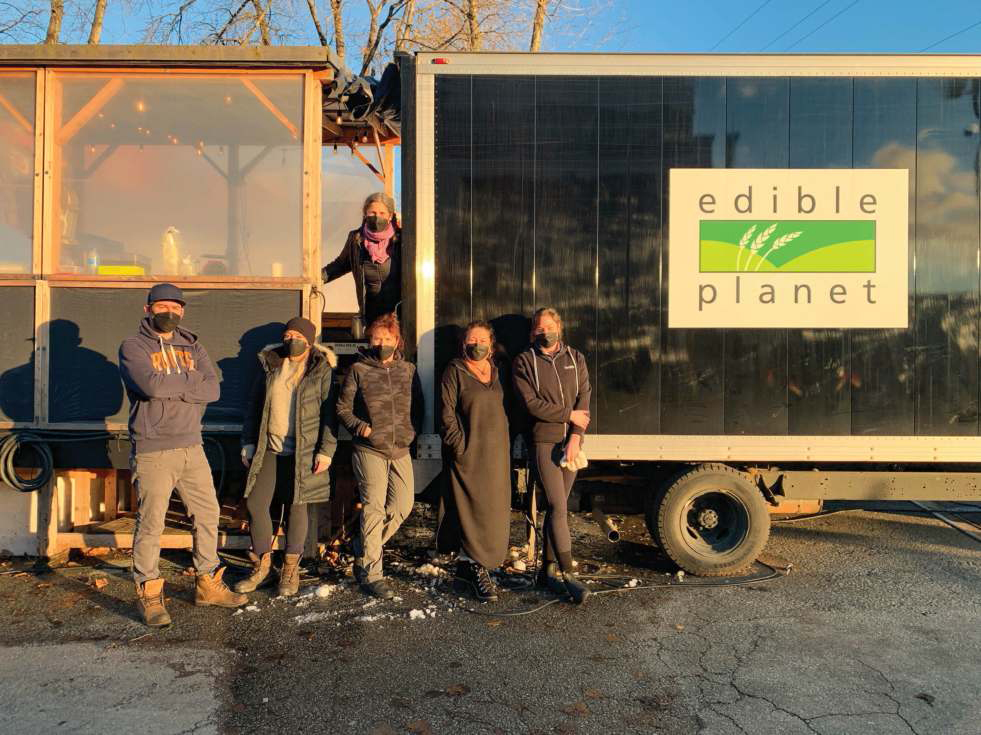
I threw myself back into that world for a few days with Lisanne Collett, co-owner and chef of the film-catering firm Edible Planet. It was an eye-opener in many respects, but the hard work and long days were very familiar.
Thirty years ago, nobody had heard of quinoa or arugula. Farmed salmon was on the menu. Borscht was made with a can of beets and powdered beef bouillon.
For lunch, two buffet tables were filled with fresh-baked bread, a hot appetizer, soup, several salads and dessert. From inside the truck, we served two entrees of either meat or fish—there was no such thing as vegetarian mains—one or two starches like rice and potatoes, and two vegetables.
We had to be good at improvising, like having to feed 75 extras with one hour’s notice. A teamster drove to the nearest corner store with a grocery list: Get all the tomato sauce, boxes of lasagna and V8 juice they had (the trucks didn’t have enough water to cook pasta, so we had to be creative). We told him to grab chocolate cake mix, orange juice, mayonnaise, sour cream and a few cans of bing cherries. Throw in a few chocolate bars to melt for frosting and ba-da-bing, we had black forest cake.
“Now we only serve Ocean Wise fish and proudly serve BC products,” Collett says. “We make chicken stock and freshly grate parmesan—we don’t take shortcuts. Avocado is a staple rather than a treat, as are roasted brussels sprouts and kale salad.” Everything tastes delicious, but Covid makes the dining experience a bit soulless. The once beautiful and bountiful buffet tables now hold prepackaged everything, from fresh-squeezed juice to salad to dessert. “The amount of disposables is heartbreaking and compostable boxes can’t compete with our decorated platters and bountiful buffet,” says Collett. “But in some ways our job is easier.”
When I joined Collett in one of her trucks, all 12 hands of the crew were on deck. Two hours before breakfast (an extra hour is needed for packing meals), Collett is juicing 12 quarts of apples and beets.
Lisa Pantages, a film caterer since 1986, is boxing several “spa breakfast” orders: two poached eggs atop avocado and spinach. Erin’s trays of pecan tarts are waiting for oven space and Rod is in the studio serving “fast track” for those in a hurry. Chef Ingrid is assembling veggie burritos and scrambling eggs.
Two more cooks are prepping tomorrow’s breakfast (400 slices of bacon are trayed and 300 eggs cracked) because you never know what they will throw at you last minute. Pantages has moved outside to chop veggies, hook up the propane tanks and electric heaters and she runs back and forth replenishing the “fast track” offerings: eggs and bacon, juice and oatmeal and today’s special, hot dogs (a big hit because breakfast was served at noon).
These days, there are a lot more special orders. “We used to have milk or cream with coffee. Now we offer oat milk, soy, almond, goat,” says Collett. A breakfast sandwich order could be “avocado and arugula on gluten-free bread, but I’ll cheat and have real mayo and bacon on the side.”
“It started with actors on trendy diets, then hair and makeup wanted what they had,” she adds. “Next came the rise of self-care, wellness therapy, gluten- and lactose-free. Everyone wanted to be vegan. And climate change concerns mean less meat—a good thing.”
“We are our own worst enemy for upping the game and it’s hard to take things away, like fresh-squeezed juice,” says Collett. “There are more vegetarians who will get their carnivore fix on weekends and we need more products for vegans, such as bespoke mayo or cheese. But our job is to service our clients and learn what they want.”
Reminiscing with former colleagues about the 15 years I spent at Reel Appetites, we all agree that it was, as Charles Dickens said, “the best of times and the worst of times.” Sure, it was exciting to meet film and TV stars, but for the most part, our job was more gruesome than glamorous.
Night shoots were particularly horrible. On one show, with rain pouring down sideways, we served breakfast at 8:00 p.m., which meant a 2:30 a.m. lunch. We still served the usual breakfast menu but with a few hearty additions, such as corn chowder, and made sure that whatever was served at lunch didn’t require a steak knife—it was safer to hold a fork and spoon at that time.
Marianne Abraham and I often teamed up in the kitchen and we had bellyache laughs. Once we were shooting 21 Jump Street next to a high school and just after lunch, a gaggle of girls ran over, hoping to catch a glimpse of Johnny Depp. They asked what he had for lunch. “Burger and chicken,” we replied. “And there’s his plate, on top of the garbage can.” They all squealed “can we have it, can we have it?” to which we replied, “sure, but it’ll cost you $20.” They rifled through pockets and purses until we told them that they could just take it, no charge. Whose plate they got, we’ll never know.
“We were at the Mount Seymour watershed with no running water or power, working 20-hour days in sub-zero temperatures and everyone was grouchy,” Abraham recalls. “Some of the cast were Americans, including John Lithgow, so whole turkeys, hams and pumpkin pies were on the menu for American Thanksgiving. I’d just put the turkeys in the oven when we were ordered to serve lunch in one hour. I said, ‘Impossible, the turkeys need four hours to cook.’
“We hacked the turkeys with cleavers and ran them to every trailer with a microwave. Sweating, we sliced and grilled the hams and everything was ready. Then we got the call—lunch was pushed an hour. Another ‘hurry up and wait.’ By noon, the turkey was rubber and the ham leather. Here’s the kicker: Nobody came for lunch. I walked to crew parking lot and security told me everyone went home an hour ago.
“I had all my dirty pots and pans soaking under the truck, hoping they would miraculously clean themselves by the time I drove away,” says Abraham. “Luckily the interior of the truck was tidy because Mr. Clean Freak (aka John Travolta) just walked in, from one end of the truck to the other, inspecting. He would flirt and joke a bit, but he was really making sure everything was spic and span. We had to make sure that fresh-baked chocolate chip cookies were always on hand. And one more thing—is this art imitating life? The crew couldn’t find him one day; one of the Teamsters had driven him to MacDonald’s… Pulp Fiction.”
Cathy Tocher also worked with me at Reel Appetites. “My first show was Roxanne in Nelson. My sister Tana (who started Reel Appetites), Shelly Adams (Whitewater Cooks author) and I were cooking on the side of a mountain without power,” says Tocher. “Someone told Shelly to make spanakopita—spinach pie. She had to look up the recipe and stayed up all night making phyllo pastry. Tana was always mad at me. She said, ‘If you don’t get wet washing the dishes, you aren’t working fast enough.’ One day Shelly saw Tana coming to the truck, so I soaked myself with a pot of water.”
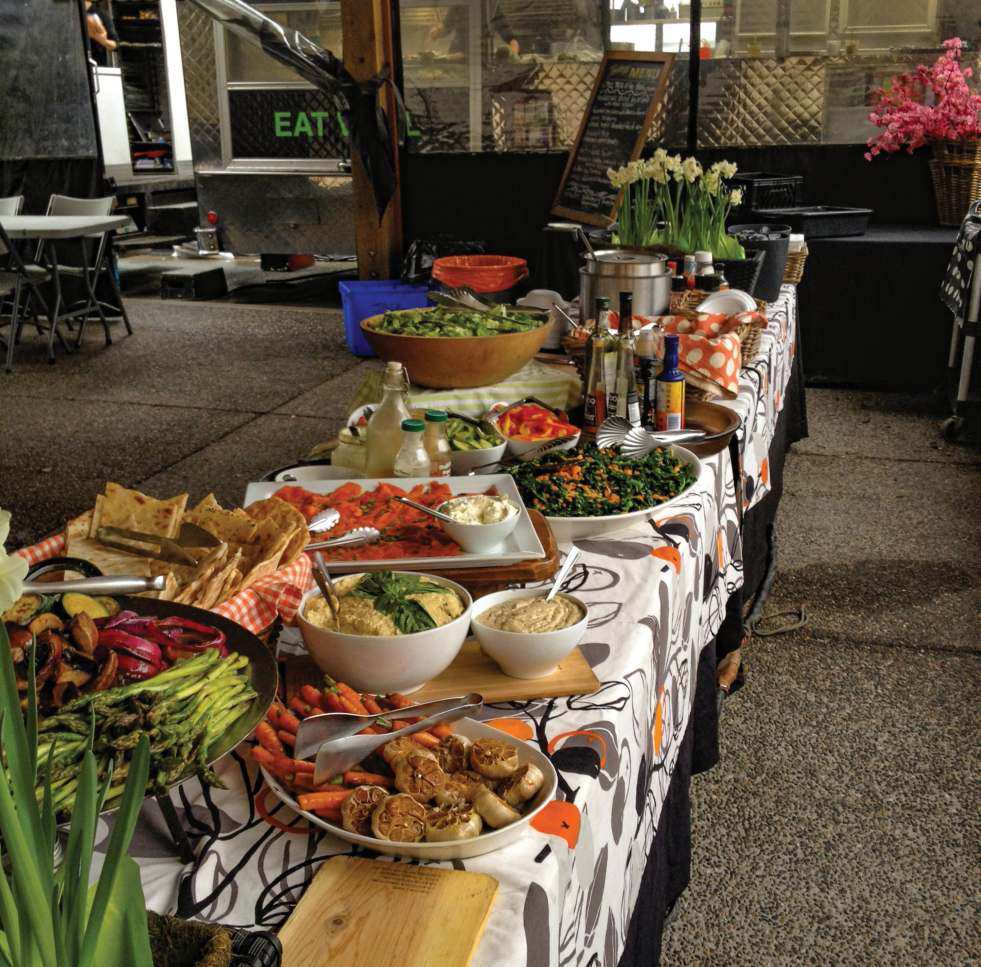
Marilyn Kopansky, co-owner and chef of Edible Planet, recalls one eventful meal in downtown Vancouver. “We were parked in the alley just east of Thurlow and I fired up the barbecue. Then we heard the fire trucks. People evacuated the office tower— the barbie was right under the intake air vent,” says Kopansky, laughing. But it wasn’t funny at the time—“the location’s manager went ballistic.”
Kopansky worked several seasons on MacGyver, which was filmed at Riverview Hospital so often she knew the patients by name. “Roderick Lewis loved talking to us. He organized our beverage cooler and cleaned our truck’s exterior—I think it gave him a sense of purpose,” she says. “Whenever we were near Oppenheimer Park, an old man who lived on the street sharpened my knives (he was a retired butcher) for a coffee and a breakfast sandwich. Could you do that today?”
Star requests, from Sensible to Stupid: One day they’re vegan, the next day on the paleo diet. Then there are the never-ending requests for macrobiotic, gluten and lactose-free meals cooked during the full moon and blessed by a personal guru in accordance with Sri Chinmoy teachings from the Atkins diet. Someone wanted her salad leaves “torn, not cut” and nothing pulled from the ground because that’s bad veg karma.
The talent weren’t always spoiled. Jack Lemmon politely asked if we could make meatloaf; Katharine Hepburn requested filet mignon on Fridays and gave us roses at the end of the show. This gastronomic turnaround came about for a number of reasons: stars made more money, productions got bigger. One theory is the decline in substance abuse in the industry: People were fuelled by carrot juice after a five-mile run rather than cocaine after last night’s partying.
I was rude to Robert De Niro the first time we met on the set of We’re No Angels. I thought it was his double. “Whaddya want?” I yelled as he stood in line deciding what to order. “Can you please hurry it up?” I barked. “I’ll, uh, can I please have some chicken and ribs?” he replied, meekly. I just about chucked it at him. After that, we got along fine. He’d saunter over to the catering truck in grey long johns and ask what I was doing, when it was obvious that I was filleting a salmon. One day my partner made him a chocolate cake, and she had to make it again and again.
On Bowen Island for the film Russia House, I drank too much vodka one night at the dailies with Sean Connery, who was passing a bottle around, and whined to him at breakfast that my hangover was his fault. So he jumped on board and helped us make an English fry-up breakfast for the crew of 150. But he was the exception.
Some stars never seemed to grasp that they couldn’t just send someone down to the kitchen one minute before lunch and ask for something that wasn’t on the menu. On We’re No Angels, Demi Moore asked if she could have angel-hair pasta and scallops, just a few hours before we were scheduled to break for lunch near Stave Lake, in the middle of nowhere. Anything is possible if the budget allowed for a helicopter to land near the closest Safeway, many miles away.
“At the end of every Who is Harry Crumb episode, John Candy threw a party; one time, he rented the airport lounge,” says Marianne Abraham, former chef with Reel Appetites. “He always bartended and chatted with everyone. John’s wife was worried about his health, so she hired a personal trainer who was trying to starve him with raw carrots. She also told us what John could and couldn’t eat, but Manny, his Mexican bodyguard came into the truck daily and asked for everything—he was sneaking food for John.”
In some ways, the job is easier now. “We have more support from the crew and everyone are team players,” Collett explains. “For instance, locations meet us at 3:00 a.m. and tell us where to park. Teamsters bring us water and dump our greywater. Sure, we still deal with the same problems and I still get anxious at the beginning of a show, but there’s less chaos.”
Some stars, such as Michael Caine, make it a condition of their contracts that certain chefs be used on their films. Caine reportedly once said: “There are only two things I ask when offered a job. Where is it? And who’s doing the catering?”
“Now more than ever, food is important; people feel cared for when they’re treated well,” says producer Lisa Towers. “Good caterers keep everyone safe and happy.”
Towers remembers that food wasn’t such a big deal decades ago. For instance, in 1994 Towers hired my company, Reel Appetites, to cater the movie Yellow Dog. In those days, there was no such thing as lactose or gluten-free. The only dietary requirements were from those who were diabetic. “People didn’t have sophisticated taste and we didn’t have the options that are offered now,” adds Towers. “But some things, like camaraderie, haven’t changed.”
The whims and dietary fads haven’t changed much either, Collett says. “We still say ‘yes’ to requests and then figure it out—we know you’re only as good as your last meal.”
A Typical Day
Behind the Scenes on The X-Files
3:00 a.m.: We arrive at the warehouse and load the van to the gunnels with supplies for the cast and crew, including 100 pounds of ice for the salad bar, 75 pounds of russet potatoes and bread dough thawed overnight. The fax machine has spit out the map to Delta. No one is there to show us where to park so we pray the teamsters won’t make us move.
Abraham slides six baking sheets of bacon into the ovens while I haul out the wheatgrass juicer for David Duchovny (we made bets on whether he’d drink it) and set up the buffet tables by the light of the truck.
6:00 a.m.: Breakfast is served.
7:00 a.m.: Crew call. We have 150 meals to prepare from scratch in less than six hours, including special dietary and vegan requests from the stars, but not before taking a break. It’s freezing outside, so we warm up by stuffing hot pancakes into our bras and we heat up mittens in the oven. Melting butter for dessert is a challenge—turn your back and it solidifies. Forget about lettuce.
11:00 a.m.: We are asked (told) to have lunch ready one hour early.
12:00 p.m.: After a few quick changes to the menu, we are ready to serve. Another hurry up and wait—lunch is held for two hours.
2:00 p.m.: We get the green light to serve: Pasta shells filled with rehydrated wild mushrooms and prosciutto, vegan shells with tofu in miso broth, and steamed broccoli branches—tops are turfed along with rubbery cod and veggies too long in the steam table. On the buffet table is a huge soup pot of minestrone, a mountain of buffalo wings, eight salads and lemon cheesecake.
3:00 p.m.: Our lunch break.
3:30 p.m.: Clean up. Wash the floor with leftover coffee, pack up and wait for our call sheet, including location, for tomorrow.
5:00 p.m.: Drive back to the warehouse, detour to dump grey water where, hopefully, no one is looking.
6:00 p.m.: Fill water tank. Call suppliers—we have an extra 50 people to feed tomorrow.
7:00 p.m.: Home. Play the answering machine: add another 50 extras for breakfast. The alarm is set for 2:30 a.m.
